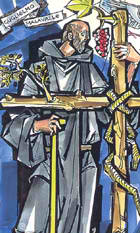THE LEGEND OF BARANGAY SAN LUCAS
San Lucas is one of the Poblacion Barangays of Magsingal, Ilocos Sur. It is situated along the National highway, northeast of the Municipal Town Hall. It is bounded by Barangay San Vicente at the south, Barangay San Basilio at the west, Barangay Sta. Monica at the north, and Barangay Patong at the east.This place consists of commercial areas because the Town Public Market was erected here and different establishments. There is also an educational institution which we call “The Magsingal Institute”, where secondary course is offered.
Residential and commercial areas has an estimated total land area of 140,000 sq. meters. Agricultural areas is about 420,000 sq. meters with an over all total land area of 560,000 sq. meters.The residential area composed of three zones. There are 471 residents living in, 151 households and 171 families excluding those who are already living abroad. Almost 98% of the residents are Roman Catholic and 2% belongs to other sects.
The source of living for the Barangay folks are predominantly on agriculture and construction workers. Almost 80% depends on crops like rice, corn, and vegetables. Although some are engaged in buy and sell as a means of their livelihood.
Due to the hardships and economic crisis of our country, the Barangay folks are not fond of social life instead they submit themselves in education and migrating to other country to find their luck in seeking greener pasture for their good future.
During the ancient times, there was a well- known strong, rich man, a Spanish looking man who served as consultant of the residents. So, they considered him as their leader or in the native dialect “pangama-en”. His name was Lucas.
In honor of his goodness to serve his fellow men the people of this place named their Barangay after him – PLACE OF LUCAS. When the town ruler ordered all the Barangay leaders of the Poblacion , the place named became SAN LUCAS. From then on up to the present the place is known as Barangay San Lucas.

